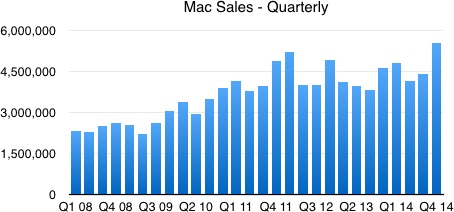Why the Mac momentum may just be starting

Q4 2014 was Apple's best Mac quarter to date, with the company selling 5.5 million units, and the $6.6 billion of revenue beating that of the iPad. Mac is without a doubt gaining momentum, and this may just be the beginning.

According to Apple CFO Luca Maestri, last quarter's Mac sales were driven by strong back-to-school sales and growth in emerging market regions. With the holiday season coming up – which is typically another strong quarter for the Mac – sales are likely to remain buoyant despite the spotlight being more on the iPhone and iPad.
Featured
Emerging markets are a definitely a place where Mac sales could grow. Last quarter saw sales climb by 46 percent in these markets, and with new lower priced devices – such as the Mac mini, which now starts at $499, the price point at which it debuted back in 2005, but over the years climbed to $599 – Apple is in a good position to see more growth.
The halo effect also has to play a part in increased Mac sales. People seem to love their iOS devices, and this will continue to play a part in generating new sales. Anything that makes people walk into Apple Stores or visit the website will help raise awareness of other products.
Then there's the closer integration between OS X and iOS 8 with new features in the latest releases such as Handoff. Hundreds of millions of iOS users are going to get new features with iOS 8 that they can't unlock unless they have a Mac. The Mac all of a sudden becomes an accessory for the iPhone and iPad, and if Apple plays this well – for example, by running adverts that demonstrate to users how this integration works and what it will do for them – then this could get people who previously weren't interested in a Mac taking a look at what's on offer.
Then there are the Macs themselves. The newer Macs are fast becoming a commodity item. Their design makes it hard – if not impossible – to upgrade as components such as the RAM and CPU are soldered directly t the motherboard, and their construction makes it hard to even get inside them to carry out upgrades and repairs on the components that can be changed. On top of that, OS X upgrades will only work on a specific range of hardware, so once Apple decides not to support the hardware any more, it's hot the end of the road.
A controlled obsolescence is built into every Mac. Sure, that's true of all devices to some extent, but Macs do have a shorter lifespan than PCs, especially if you rely on software upgrades. And the tighter people are in the iOS/OS X ecosystem, the harder they are going to find it to escape.
Apple has been happy for Mac sales to coast along in the 3.5 to 4.5 million range for several years now, but that looks set to change. Apple is gambling that it can better sell the Mac by integrating them more tightly with iPhones and iPads, and by making them more accessible prise-wise, especially at the low end.
Will it work? The sales figures for the next few quarters will tell.
See also: